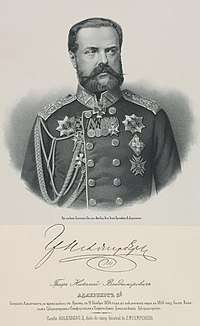Count Nikolay Adlerberg
| Nikolay Adlerberg | |
|---|---|
 | |
| Born |
19 May 1819 Saint Petersburg, Russian Empire |
| Died |
25 December 1892 (aged 73) Munich, German Empire |
| Occupation | Statesman |
| Spouse(s) | Amalie Adlerberg |
Count Nikolay Vladimirovich Adlerberg (Николай Владимирович Адлерберг; 19 May 1819 – 25 December 1892), Councilor of State, Chamberlain, governor of Taganrog, Simferopol and Finland.
Biography
Nikolay Adlerberg was born into a Swedish noble family of Adlerberg on 19 May 1819 in Saint Petersburg. His father, Vladimir Fyodorovich Adlerberg was a close friend of Nicholas I; in 1852-1870 he was President of the Russian Imperial Post Department, who introduced the first Russian post stamps.
Nikolay Adlerberg graduated from the Page Corps of His Majesty in 1837, and in 1838 appointed aide-de-camp to the Emperor; participated in wars led by Russia in Caucasus (1841–1842) and Hungary in 1849. After the Hungarian campaign he was promoted to the rank of colonel and awarded with golden weapons.
Adlerberg resigned in 1852 and was attached to the Russian Ministry of the Interior, receiving the title of the chamberlain in the court of His Majesty the same. On 10 June 1853 Adlerberg was appointed Governor of Taganrog, but he left the Governor's office into the hands of general Yegor Tolstoy in spring 1854 due to declared state of war in Taganrog and proximity of Crimean War actions.
In 1855, Nikolay Adlerberg was promoted to the rank of mayor-general and married Amalie Gräfin of Lerchenfeld (1808–1888) (in the first marriage Baroness Amalie von Krüdener).
Count Adlerberg served as governor-general of Simferopol and Taurida Governorate (1854–1856) during uneasy period of the Crimean War. Later he served at the Imperial Russian Diplomatic Mission in Berlin in 1856-1866. Nikolay Adlerberg was promoted to the rank of lieutenant-general in 1861 and infantry-general in 1870, and during sixteen years served as Governor-General of Finland (1866–1881). Being a theater enthusiast, he established the Russian Theater in Helsingfors in 1868, which was named Alexandre Theater in 1879 after Alexander II of Russia.
On 22 May 1881 the Count was named member of the State Council, but was pensioned off from this post after assassination of his protector, Emperor Alexander II of Russia. Nikolay and Amalie Adlerberg moved to Germany, where they settled at Maximilian Lerchenfeld's estate in Tegernsee near Munich.
Nikolay Adlerberg died on 25 December 1892 in Munich, Bavaria.
Awards
- 1842 - Order of St. Anna of 3rd degree
- 1849- Order of St. Anna of 2nd degree
- 1848 - Order of St. Vladimir of 4th degree
- 1854 - Order of St. Vladimir of 3rd degree
- 1855 - Order of Saint Stanislaus of 1st degree
- 1859 - Order of St. Anna of 1st degree
- 1865 - Order of St. Vladimir of 2nd degree
- 1867 - Order of the White Eagle
- 1872 - diamond decorations of the Order of St. Alexander Nevsky
- 1876 - Order of Saint Vladimir of the 1st degree
._%E2%80%94_%D0%A2%D0%B8%D1%82%D1%83%D0%BB%D1%8C%D0%BD%D1%8B%D0%B9_%D0%BB%D0%B8%D1%81%D1%82.jpg)
Trivia
- In 1845, Count Adlerberg traveled through Greece, Egypt and Palestine, which was described in his book From Rome to Jerusalem (Из Рима в Иерусалим) (published in 1853). The book received good response from the literary critics and received favorable reviews in the journal "Sovremennik" (1853, volume 39, pp. 45–52), and was famous in the 1850s. He undertook the second trip to Palestine in 1860, which was described in his book En Orient, impressions et réminiscences published in French language in Saint Petersburg, 1867.
- On his trip to Palestine, Count Adlerberg visited and prayed at the Church of the Holy Sepulchre, and after this Adlerbergs financed the building of a new Russian Orthodox church dedicated to Saint George (Церковь святого великомученика и победоносца Георгия) in Al Karak. Its construction was completed in 1847 and the church was consecrated on 17 July 1849.
- Count Adlerberg loved theater, he wrote a book Les Artistes des théatres impériaux de St. Pétersbourg : photographies d'après nature, avec esquisses biographiques, published in Saint Petersburg in 1863, and in 1879 built a theater in Helsinki while being Governor of Finland. This theater was named after Alexander II of Russia Aleksanterin Teatteri, also known as the Russian Theater.
See also
References
- This article includes content derived from the Russian Biographical Dictionary, 1896–1918.
- full text of En Orient, impressions et réminiscences by count N. Adlerberg, 1867
| Political offices | ||
|---|---|---|
| Preceded by Alexander Lieven |
Governor of Taganrog 1853-1854 |
Succeeded by Yegor Tolstoy |
| Preceded by Platon Ivanovich Rokassovski |
Governor-General of Finland 1866-1881 |
Succeeded by Frederick Heiden |